Impact of rapid on-site evaluation in expediting the fast investigative lung cancer pathway
Abstract
Objective
EBUS-TBNA is a method of acquiring tissue samples from intrathoracic lymph nodes and central intrathoracic tumours in patients suspected of having lung cancer. Rapid on-site evaluation (ROSE) denotes assessing tissue samples during EBUS (or bronchoscopy), providing instant feedback on sample adequacy and provisional cytomorphological diagnosis. Sector multidisciplinary team (MDT) discussion can then make informed treatment decisions, with confirmatory immunohistochemistry being finalised before provision of final treatment. Currently, impact of ROSE on length of time patients spend on the lung cancer diagnostic pathway remains unclear.
Methods
We retrospectively evaluated the impact of ROSE on the length of time between patients' EBUS/bronchoscopy procedures and discussion at sector MDT, referred to as time to treatment decision (TTD), at our institution. Additionally, we assessed impact of ROSE on number of passes (number of times nodes/masses were sampled) per procedure.
Results
The mean TTD was 77.9% shorter (p = 0.001) with ROSE present than when absent. Patients who received ROSE spend 34.3% less time (p = 0.028) on lung cancer diagnostic pathway overall. There was a significant reduction in number of passes in non-malignant nodes with ROSE present (2.23) than when absent (3.14) (p < 0.001). With ROSE present there was a significantly greater number of passes at malignant sites (5.07) than non-malignant sites (2.23) (p < 0.001).
Conclusions
These findings support conclusions made in our institution's previous study, that utilisation of ROSE reduces TTD. ROSE also allows safe advancement through nodes with low suspicion of malignant involvement, focusing time on sampling nodes/masses of greater suspicion.



 求助内容:
求助内容: 应助结果提醒方式:
应助结果提醒方式:


